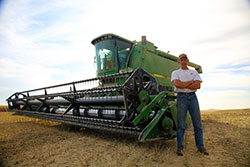|
That Little Bugger
Nitrosomonas verse
Yeast.
Can NH4 remain NH4 and the weeds can starve.
Can NH4 remain NH4 to
feed the crop plants and starve the smallest of weeds.
 1
1
Meet the problem
head on. Nitrosomonas.
“Nitrosomonas
is a very small
plant that is out of place. It is a very small weed that robs
society and crop production farms.” GJS
Crop producers
have been feeding the nitrifying bacteria and not the crop. This is
called nitrification….and not denitrification which is another story
all on it is own.
Now we can slow
down and starve the Nitrosomonas and feed the favorable bacteria
like Yeast and better yet feed the growing crop Ammonium which the
crop prefers.
Keeping this
“Little Bugger” on the bench and not in the game while growing a
good crop is key.
Nitrosomonas is like a little weed in the crop robbing the plant of
nutrients.
Even though a
more mature crop can use nitrate , valuable energy is lost to
convert nitrate NO3 back to NH4 or Ammonium. This is a 18% energy
loss to convert back to Ammonium.
This is one
reason why only Ammonium is used in starter fertilizer. The young
plant can not convert or assimilate Nitrate. Starter Fertilizer
always starts with the word Ammonium because it is most efficient
for the plant.
Clean water and
clean air comes with the use of a bacteriostat and not a bactericide
for control of the Nitrosomonas.
Remember the term -stat means to stay put or stall while the term -cide
means to kill.
The -cide function of controlling bacteria costs a lot of money, may
impart control to other favorable bacteria and does require a full
EPA review like N-serve at $15.00 per acre.
Zinc30 provides
a means to stall and starve bacteria like Streptococcus and
Staphylococcus (Dr. Christopher DeWitt, Australia, 2103) by binding
tightly with the Co-factor Copper29 or Manganesse25 in certain
types of bacteria which includes Nitrosomonas and its Co-factor
Copper29.
This is the Achilles Heel of bacteria… The Co-factor is put into a
metallurgical bind with Zinc slowing and stopping the movement of
proteins past the cell’s importing nutrient valves. The transporter
mechanism fails to supply nutrition to the bacteria.
Targeted Zinc+2,
Zinc Oxide, Zinc Acetate, and Zinc Sulfate stalls the growth of
Nitrosomonas and allows other bacteria like Yeast to flourish.
A small amount
of Zinc is required and should not be over-applied and rates can be
as low as 1 ounce per acre for Zinc Acetate….maybe $1.00 per acre
to feed the Yeast and starve the Nitrosomonas with Exactrix®
technology.
One of the
reasons there is such a run away problem with nitrate and nitrous
oxide is the high population of Nitrosomonas from depletion of
acceptable Zinc levels in our eroded soils that need help, such as
cover crops.
Zinc is a
valuable micro nutrient and critical to human health. A lack of
Zinc in the human diet results in many maladies of the human body.
Low Zinc
availability in the soil allows Nitrosomonas to be directly
correlated to the rapid breakdown or oxidation of NH3 as soil placed
NH4. NH4 erodes chemically to NO2, NO3 in presence of the “Little
Bugger”.
Depletion of
normal soil Zinc levels allows healthy Nitrosomonas colonies to
rapidly convert Nitrite NO2 in anaerobic conditions to
Nitrous Oxide N2O….this
is a Exactrix Target Theory. It is an educational fact never before
explained to crop producers.
Nitrous Oxide is
a nasty Green House Gas and 300 times more damaging than CO2 to the
Ozone layer. Agriculture delivers Nitrous Oxide in profuse amounts
of 62.5% of the total amount emitted into the air and ozone layer.
Other
Nitrobacteria are also in the depletion cycle to mobile Nitrate,
NO3. Only Nitrosomonas has the ability to double step or convert
back to N2O, nitrous oxide
from NO2, nitrite.
The double step
capability of the bacteria Nitrosomonas is responsible for billions
of dollars of Nitrogen lost into the environment as N2O and NO3..….
both upward into the ozone and downward into the water.
For crop
producers had the original or normal levels of Zinc in soil s of the
Great Plains and PNW there would be much higher levels of commercial
fertilizer performance and lower requirements for placed Nitrogen.
What if the
deep North American soils had normal levels of crop available Zinc.
The crop producers would have much better crop root systems with
higher yields. Proper rates of applied Zinc will produce much
higher levels of NPKS performance under the rules of mobility.
Our food supply
needs Zinc at our original soil stored levels and this would produce
a healthier society.
 2
2
Nitrous
Oxide is 300 times more damaging to the environment than CO2.
 3
3
How
the NP reactor works. Video
Exactrix
ZHXE-3200 with Nano Particle Reactor, Zinc and Zinc Oxide, Zinc
Sulfate, Zinc Acetate is utilized in the reactor Biological Weed
Control for about $1.00 per acre with the plant nutrient Zinc and NP
Zinc is also a bacteriostat.
Keeping the
costs in line at miniscule rates of Zinc can produce amazing
economic results in the overall per acre cost of fertilizer and good
yields in the crop.
-
Zinc improves the plant health and maintains a
vibrant soil life feeding Yeast as an example.
-
GHG as Nitrous Oxide can be greatly reduced by
employing control over Nitrosomonas .
-
Zinc is unique since it favors human nutrition and
improves the performance of soil bacteria like Yeast.
-
Rates as low as 1 ounce per acre can produce good
results with Zinc Acetate as an example.
Your Great
Plains Reporter,

Guy J Swanson.
www.exactrix.com
NH3 Efficiency Experts
Exactrix Global Systems
|







